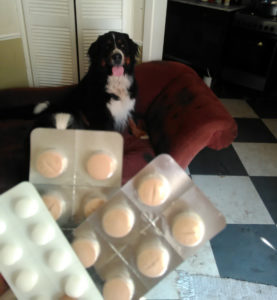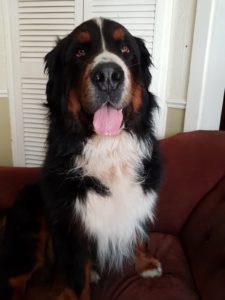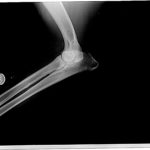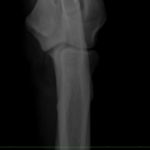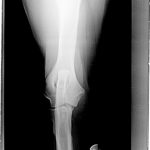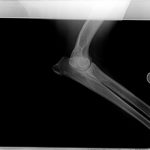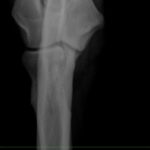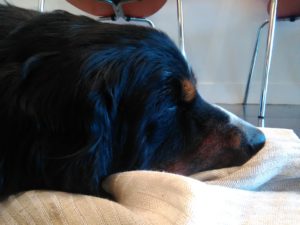On Friday the 17th of August 2018 I took my 4-year-old Bernese Mountain Dog Pasha to a specialised clinic for his CT-scan. Pasha has been periodically limping with his front legs for approximately two years due to what his vet and I perceive to be arthritic problems and forms of elbow dysplasia such as Fragmented Coronoid Process (FCP). Pasha’s condition is comparable to what his one year younger brother Aubrey suffers from in a stronger degree and which Aubrey was operated on two years ago. Pasha’s other packmate, 7-year old Stockard, was also diagnosed with a lighter variation of elbow troubles (very mild case of Fragmented Coronoid Process) 5 years ago. This blog describes how Pasha became a chronically limping dog and how the vets and I arrived at the conclusion that a CT scan should be made.
Living with limping dogs
Practically speaking, living with three big dogs that have arthritis and elbow dysplasia means that from time to time, one of them will inevitably limp, be lame and/or display stiffness for a few days. Especially when the weather changes. It’s very comparable to human arthritis in that respect. A change to cooler and damper weather usually makes this condition flare up. With some proper management and a bit of rest, these limping episodes are usually short-lived and not overly problematic. Focussing on Pasha now, a telling sign that something isn’t quite right with his front propulsion system is his gait. When Pasha walks, he turns his elbows outwards, which turns his paws in. If we’d use a human analogy, we could say Pasha walks O-legged. As far as I can recollect, this started ever since he reached his full grown size, which these dogs reach in both an incredibly fast but at the same time very slow rate. But that’s a whole other topic for a different article some time. Let’s just say: “it’s complicated” for now… 😀

My three boys. From left to right: Aubrey, 3 years old, Pasha 4 years old and Stockard, 7 years old. And yes we know, dirty floors. Time to clean them. Again. 😛
Having a pain-fighting strategy in place
Ever since Stockard broke his hind leg in the backyard in the spring of 2011, and we were very lucky that I happened to have Novacam on hand, an almost over-the-counter NSAID (Nonsteroidal anti-inflammatory drug – Wikipedia, basically painkiller/anti inflammatory drugs) and I swiftly softened the initial pain he suffered from this accident with it, I make sure I always, always, always have this in the house. My vet supplies me this on request but without prescription and over the years we developed this working relationship that enables me to independently diagnose minor movement troubles in my dogs and apply the Novacam at my own discretion. For anything more serious or dubious-looking I always phone the vet for consult before I take further action. The vet and I follow a policy of continuing the Novacam for seven to ten days, provided there’s a marked improvement after three. This arrangement enables me to recover my dogs from most of their limping episodes without any veterinary interference. As I deal on average with 3 dogs times 2 to 3 limping episodes each per year, this has become a standard routine in the care of my dogs over the years.
Pasha’s previous limping episode
Since the spring of 2018 Pasha’s limping episodes became more frequent and more severe. The routinely administering of painkillers/anti-inflammatory and moderating exercise just didn’t seem to do the trick for Pasha anymore. By mid-May 2018, Pasha suffered a sudden and severe crippleness in his right front leg. This rather freaked me out at the time, enough to call the vet on their emergency line on a Saturday afternoon. We eventually didn’t decide to take him in that day, but try the routine treatment first. It was all really rather curious. Pasha walked as if the leg was actually broken, poor boy. But he was totally fine with me touching it, bending it and carefully testing it. And he was still almost as lively and active as ever in spite of this limp! Dogs. They never fail to amaze me… Additionally, Pash had nothing in the way of a fever, his appetite was well up like a proper Berner ought to have, there was just that dreadful looking limp… And get this: it lasted for only 12 hours! I think the shortest limping episode I’ve ever seen with any of my dogs was like three days. Until this one, that is. Anyway, within 12 hours, it was completely gone. Very strange indeed!
Pasha’s current limping episode
Pasha started limping again a couple days after he and the other dogs got their Rabies shots late July ’18. This only occurs as an afterthought to me but there are studies out there suggesting there’s a correlation between vaccinations and limping. I certainly didn’t make the connection at the time. But here’s an article describing vaccinosis, which is what we’re talking about here. I honestly don’t know what to make of all this yet. But in future blogs I will try to gradually formulate my personal take on alternative and homoeopathic treatments for dogs versus traditional canine medicine.
- The pet passports with Rabies vaccination batch number stickers.
- Strips of Tramadol and Previcox for limping dog Pasha.
- Pasha taking it easy on his sofa.
- A Pasha portrait. 🙂
From intermittent acutely limping to chronically limping
When I noticed that Pasha was limping again, with his left front leg this time, I assessed this limp as ‘severe’ as well, but not as bad as the previous 12-hour one. It worried me a great deal, as it was only two months since his previous limping episode was averted. Moreover, as an additional complication, the weather had been, was and showed every sign of continuing to be exceptionally hot. Bernese Mountain Dogs generally don’t tolerate the heat very well, so, keeping my three Berner boys comfortable & happy was already challenging enough. Last thing you’ll want is a bloody limp under such circumstances… Not that you’d ever want one but with all that heat and dry toasty air blowing about you don’t expect it to flare up either. One blessing though was that the dogs and I were already swimming more than we walked and swimming is usually the prefered mode of exercise for limping dogs.
Initial response to Pasha’s limp
I always respond to a limp with the Novacam routine I outlined above, along with filming the limping dog in question and sharing those videos with our vet and on Facebook, where I’m fortunately connected to a group of fellow-big dog owners with centuries of experience in living with big dogs between them. This is another routine I employ when one of my dogs is limping. Get a whole bunch of experienced and smart fellow dog owners to help you diagnose and put their thinking caps on for your sick doggy. 🙂 It’s truly great and helpful and certainly gave me a few eye-openers on occasion. And as usual, a couple hours of focussed commenting and chatting left me with plenty of input on possible diagnosis and treatment for my Berner boy. Meanwhile, my instinctive first reaction is always to kill or at least minimise any pain my boys might experience and Pasha was duly taken off the Novacam and put on Previcox instead when I saw no improvement on the former and the phone call with the vet was made.
NSAID upgrade: Novacam replaced with Previcox
If it hadn’t been for the 35 degrees Celcius weather around that time I would have taken Pasha in for an examination at this point. Thankfully the vet had enough to go on with my own observations and video’s in order to go ahead and prescribe the Previcox. As I discovered, Previcox is a stronger and more advanced NSAID. Along with the Previcox, I picked up Tramadol as well as an optional medicine at the vet’s. I gave Pash two doses of this and then noticed it was making him weird in the head. Both the vet and the big dog facebook crowd urged extreme caution with this medicine. Reason I decided to give it a go anyway was Pash still giving clear indications of pain. I sincerely hope I’ll never have to use Tramadol again. Here is an article on how inefficient and generally bad Tramadol is. Besides the NSAID upgrade, I also introduced Devil’s Claw and Glucosamine as supplements to Pasha’s diet by my own initiative (sanctioned by the vet and facebook support crowd though). This package of measures certainly seemed to give him a fair amount of relief after a couple days, manifesting itself in a happier and livelier Pasha who walked slightly better than before. My uneducated guess is that it’s mostly the Previcox that should be credited for this improvement.
Need for further diagnosis of limping dog arises
Still, on the whole, I observed some significant changes taking place in my big dog’s behaviour. Pasha never moved really well of course but a close friend who frequently walks with us pointed out how it’s more pronounced now. What I could clearly tell myself is that he would tire out on the walks sooner. Sure, there was a cracker of a heatwave going down, but that’s one advantage of living with three big dogs instead of one; you can always compare them to each other and thus more accurately assess how much the weather or any other circumstance might be impacting them. I’ll just reiterate that swimming is a really good idea when you’re living with big dogs here… At home, I found Pasha a bit more lethargic as well. This would manifest itself in him camping out under my desk more than usual and choosing to continue his nap on the floor or the dog sofa rather than venturing into the backyard with the other boys and me. Nothing drastic, but all these little things were certainly noticeable. That friend I mentioned earlier said she felt “Pasha had been a bit quiet lately”. It became most apparent a more thorough diagnosis should be made and fitting treatment pursued for Pasha.
Diagnosing and medicating a limping big dog
Pasha had his elbows x-rayed in 2016, when his limping episodes first cropped up. It made sense to redo those images, just to see how far the arthritis might have advanced and what the FCP looks like nowadays. Well, the x-rays we made on the 11th of August 2018 were a bit of a surprise. A double surprise actually. Firstly, it all didn’t look nearly as bad as we all anticipated! And secondly, the right elbow looked worse than the left! In a way, I was relieved to learn we have been successful at keeping the arthritis at bay. On the other hand, Pasha was still clearly sparing his left front leg for a week now and I really wanted the hurting to end and to know what exactly causes Pasha’s lameness.
- X-ray of Pasha’s right elbow made in 2018.
- X-ray of Pasha’s right elbow made in 2016.
- X-ray of Pasha’s right elbow made in 2018. Front view.
- X-ray of Pasha’s right elbow made in 2016. Front view.
- X-ray of Pasha’s left elbow made in 2018. Front view.
- X-ray of Pasha’s left elbow made in 2016.
- X-ray of Pasha’s left elbow made in 2018. Front view.
- X-ray of Pasha’s left elbow made in 2016.
Click on the thumbnails of Pasha’s x-rays to compare the state of his elbows in 2016 and 2018.
Prednisone injection into the arthritic elbow joint
Going on Pasha’s limping history and his orthopaedic observations mostly, the vet proposed to try a Prednisone injection into Pasha’s elbow joint. I knew Prednisone is serious painkiller drugs for humans and had heard from my online big dog support group it’s used in canine medicine as well. Anything to ease Pasha’s pain more I thought so gave the go ahead without much further thought. Pash was still unconscious from the narcotics for his x-rays so the vet immediately proceeded with extracting a little liquid from the elbow joint and injecting the same amount of prednisone solution. I did see some further improvement with Pasha’s limping the next day and no signs of pain anymore, which was quite the relief for both Pash and me of course.
- Pasha sleeping the narcotics off after his x-rays and prednisone injection.
- Closeup of Pasha sleeping the narcotics off after his x-rays and prednisone injection.
- Pasha (front) reunited with Stockard and Aubrey after his x-rays.
Cartilage related or muscles and tendons?
Naturally, I shared the x-rays with the Big Dog gang on facebook later on and we ended up with two predominant scenarios: Loose cartilage or other cartilage-related problems (cartilage is not visible on x-rays) being the first line of thinking.The other theory was that Pasha was compensating his bad right elbow with his left and thus ended up spraining the latter. Pasha’s breeder, who is one of the best in her trade in my opinion, is always quick to react, think, comment and offer support whenever any of the pups she ever reared is in trouble, suggested a CT scan be made. After pain relief, getting the correct diagnosis for any of my big dogs is top priority when they’re ill or limping. So, seeing how the x-rays only left everybody still guessing (as x-rays quite often do when you’re trying to diagnose a limping dog), levelling up and getting Pasha ct-scanned only made sense. For the meantime, we would try to roll on with what our vet recommended: Previcox, controlled exercise (on lead at first and no walking on very sandy surfaces) involving a good amount of swimming (but once again ‘controlled’) and some weight loss if possible at all.
In my next blog, you can read how I took Pasha to Pet Hospital Drachten for his CT scan.


